Hartlepool Electric Tramways
History
Construction of the first electric tramway system in the Hartlepools, and indeed in all of northeast England, started in late 1895, the first services running around six months later on the 19th May 1896.
The tramway was owned and operated by the General Electric Tramways Company, which was a subsidiary of the Electric Construction Company, the latter having taken over the assets of the defunct 3ft 6in-gauge Hartlepools Steam Tramways Company in late 1894, subsequently setting up the GETCo — on the 28th February 1895 — to build and operate the tramway.
Powers to reconstruct the tramway for electric working were acquired via the Hartlepools Tramways Order 1895, which was passed into law on the 6th July under the Tramways Orders Confirmation (No 2) Act, 1895. The first electric services were handled by three tramcars, the fleet gradually being expanded to ten vehicles by late 1897.
Further powers were obtained under the West Hartlepool Tramways Order 1898, which was passed into law on the 2nd August under the Tramways Orders Confirmation (No 3) Act, 1898. These powers authorised the GETCo to build an 0.28-mile deviation along Clarence Street in West Hartlepool, avoiding the western end of Church Street; this had, in fact, already been opened almost a year before under a provisional authorisation.
The key figure in the above story was Stephen Sellon, who not only acquired the defunct steam tramway on behalf of the ECCo, but also secured the support of the corporations of Hartlepool and West Hartlepool — through whose areas the steam tramway had run — for its conversion to overhead electric traction. Importantly, Sellon also managed to secure West Hartlepool Corporation's agreement to defer the date at which it had the right to buy the tramway within the borough, from 1897 to 1911, as the old date would have made the scheme financially unviable.
Whilst the above powers belonged to the ECCo, Sellon had also, and independently of the ECCo, applied for powers to build a series of tramway extensions within West Hartlepool, together with a Francis Ashby. In late 1894, however, Sellon left the ECCo (taking the extension application with him), along with the ECCo's Managing Director, Emile Garcke, both men being keen to seize the opportunities that electric traction was opening up.
Sellon and Ashby's application was passed into law on the 6th July 1895 via the Hartlepool Electric Tramways Order 1895, which authorised 2.18 miles of new lines, and was part of the same parliamentary act as the EECo's order.
Shortly afterwards, on the 7th November 1895, Garcke, with help from Sellon, set up the British Electric Traction (Pioneer) Company, which one year later, on the 26th October 1896, became the British Electric Traction Company. The BETCo began life by purchasing numerous horse and steam-operated tramways with the intention of converting them to electric traction, as well as promoting schemes for new tramways; it would, over the course of its existence, go on to either own, part-own or lease around 50 tramway systems across the British Isles. Shortly before the formation of the BETCo, the BET (Pioneer) Co entered into an agreement with Sellon and Ashby, and on the 15th October 1896, it registered a subsidiary — the Hartlepool Electric Tramways Company — to construct and operate the authorised electric lines in West Hartlepool.
Whilst it seems odd that two companies independently applied for powers to build and operate tramways within the same town (West Hartlepool), there was clearly a lot of discussion behind the scenes, which was especially important for the HETCo given that its lines would not have been viable, either financially or operationally, in isolation. Moreover, the close professional (and personal) relationship between the EECo and the BETCo, both here and elsewhere, meant that it would only be a matter of time before the two tramways were consolidated.
Work commenced on the HETCo's new lines on the 5 April 1897, with the HETCo acquiring the GETCo (from the EECo) in January 1899, shortly before services commenced over the new lines on the 10th March, five new cars having been acquired for this purpose. Although the tramways were soon operated as a single system, the GETCo continued to exist as the legal owner of the reconstructed former steam lines between Hartlepool and West Hartlepool.
Before the opening of the new lines — to Park and Foggy Furze — the HETCo had already applied for powers to build 2.7 miles of new lines, including a 2.2-mile southern extension from Church Street in West Hartlepool to its namesake in Seaton Carew. However, following several objections from West Hartlepool Corporation, authorisation was not received until the 11th August 1898, in the form of the West Hartlepool Light Railways Order 1897, and even then further objections were raised, delaying construction yet further.
Despite the glacial pace of the above process, in 1900 the company sought powers for a further 1.8 miles of tramway, as well as to extend the time allowed for construction of the lines in the 1897 order. However, by the time the Light Railway Commissioners considered the application, the extensions had been dropped, so all the company got was approval to move its planned Seaton Carew line slightly to one side due to planned road widening. Authorisation was granted on the 19th February 1901 by the West Hartlepool Light Railways (Deviation Etc) Order, 1901.
Work on the southern extension finally began in earnest in February 1901, but issues with a rail underbridge meant that when services commenced (on the 28th March 1902), they could not run across the bridge, shuttle services running either side of it until late 1902, by which time the North Eastern Railway Company had completed the bridge's reconstruction. For this new service, four new trams arrived, which apart from rebuilds, were the last purchased by the HETCo, the maximum size of the fleet under the company being 21 vehicles.
With the joining of the severed Seaton Carew line, the tramway reached its maximum size of 6.98 miles. It took the form of a cross centred on Library Corner, West Hartlepool, with lines running: northwards along Clarence Road and Cleveland Road to Northgate in Hartlepool; eastwards along Church Street then southeastwards via Seaton Road to Seaton Carew; southwards along Stockton Street to Foggy Furze; and westwards along Victoria Road to Park. Although various plans were made by other companies to link the tramways of Middlesbrough with those of Hartlepool, none ever came to fruition.
The tramway was not particularly profitable, and whilst never making a loss, after all interest payments and loan charges had been made, a dividend was only paid in 3 out of the 13 years the tramway was owned by the HETCo. Nevertheless, West Hartlepool Corporation, or at least elements within the corporation, seemed keen to purchase the various tramway lines as and when they became due. Unfortunately for the corporation, there was no single date when they could exercise their option to purchase the undertaking, as the system had been constructed by two different companies, under several authorisations, with dates falling due in 1909, 1911, 1922 and 1925. If that wasn't enough of a challenge, it seems that the corporation wasn't even sure that it wanted to purchase the tramway, its general approach probably best being characterised as shambolic, decisions being taken that turned out to be non-quorate, decisions being made then overturned, and all against a deadline that they clearly hadn't prepared for (they were required to give six months notice of their intention to the company). On top of that, the corporation then challenged the company's valuation of the first two lines they had the option to buy (Park and Foggy Furze), which ended up in arbitration with an award very close to the HETCo's, which the corporation then rather unwisely appealed, only to be given a fairly public rebuke for wasting the Lords Justices time.
The corporation took ownership of the Park Foggy Furze lines on the 25th September 1911, the date the HETCo had communicated that it would cease operating services on the line; the corporation was, however, in no position to operate the lines itself, and in fact, seemed to still be unsure whether it wanted to become a tramway operator or not. As a result, it was forced to lease its newly acquired lines back to the HETCo on what turned out to be quite punitive terms, the corporation eventually making a substantial loss on the arrangement. Additionally, the corporation had to pay interest on the purchase price of the two lines (back-dated to the 6th January 1910), which it had not yet paid, as it was ostensibly considering yet another appeal. The upshot of the delay was that it was ordered to pay up, the Justice in the case pointedly remarking — on the 7th November 1911 — that he would "give the corporation no more time to play the fool".
In 1912, after all this prevarication and uncertainty, the corporation eventually decided to bite the bullet and negotiate with the company to purchase all the remaining lines, rather than wait for them to expire and thus become available for purchase. This was, however, complicated by the rather inconvenient fact that around 1.25 miles of the enterprise were within the boundary of Hartlepool Corporation; these were, in the end, retained by the GETCo (the legal owner), West Hartlepool Corporation leasing them from the company. With the exception of these lines, ownership and operation of the tramway formally passed into the hands of West Hartlepool Corporation on the 31st August 1912.
Ahead of the change in ownership, West Hartlepool Corporation acquired powers to operate or lease the tramway, as well as to build 3.39 miles of extensions. These powers were granted by the West Hartlepool Corporation Tramways Order 1912, which was passed into law on the 7th August under the Tramways Orders Confirmation Act 1912; however, none of these lines were constructed.
The corporation, which had already relaid the Park line, now turned its attention to renewing life-expired rails and overhead elsewhere, as well as ordering five new tramcars, which arrived in 1914, and rebuilding existing vehicles. This renewal effort proved to be very timely, placing the system on a good footing ahead of the coming conflict. Like all systems, the WHCT was placed under immense strain during the Great War, with greatly increased passenger loadings (which doubled during the war years), minimal maintenance and severe restrictions on the purchase of spares, rails and new tramcars, not to mention suffering damage from direct action from enemy warships (surely unique for a tramway), which all told killed 127 people in the Hartlepools.
After the war, the WHCT set about putting the tramway concern on an even keel, renewing track, catching up on maintenance and obtaining what would turn out to be the last new tramcars, six in 1920, and two in 1923. The corporation had also given thought to motorbus operation, both as feeder services to the tramway, and to secure against encroachment by others. Powers to operate motorbuses within the borough were granted on the 15th August 1919 under the West Hartlepool Corporation Act 1919. The corporation had also applied to construct over five miles of tramway extensions, predominantly southwards, but only received powers for 2.4 miles, which would not have been viable in the absence of the rejected line, and which were, therefore, not built. The first corporation motorbuses commenced operation on the 17th July 1920, though it was to be a long time before they turned a profit.
Challenging times now lay ahead, with local industries struggling and passenger numbers falling fairly dramatically, so economies needed to be found. As a result, when the Foggy Furze route came due for track renewal, the corporation took a long, hard look at its options and decided on the 13th June 1922 to seek powers to replace the tram services on the route with trolleybuses. The corporation duly applied for powers to build circa 20 miles of trolleybus routes, these being granted on the 2nd August 1923 under the West Hartlepool Corporation Act, 1923. The last tram on the Foggy Furze line ran on the 4th October 1923, motorbuses then taking over temporarily until the line was reconstructed for trolleybus operation, the latter's inaugural services commencing on the 28th February 1924. Somewhat surprisingly, powers to abandon the Foggy Furze line were not obtained in the 1923 act, but later under the West Hartlepool Corporation (Tramway Abandonment) Order, 1924, on the 18th July that year. This suggests that in 1923, the council still regarded the trolleybuses as an experiment, with the tramway being retained as a fall back; however, this position quickly changed.
Hartlepool Corporation took over ownership of the tramway tracks within its municipal boundary on the 3rd August 1925, the WHCT continuing to operate tramway services, but having agreed to convert the route to trolleybus operation. The transfer and agreements were confirmed on the 2nd August 1925 under the West Hartlepool Corporation (Trolley Vehicles) Order Confirmation Act, 1925, and the Hartlepool Corporation Act, 1925. Hartlepool followed this up with powers to abandon the tramway and operate trolleybuses; these were granted on the 30th June 1926 under the Hartlepool Corporation (Trolley Vehicles) Act, 1926.
Despite the fact that much of the system had plenty of life left in it, conversion now gathered pace, the last trams on the Park line running in November 1925, with temporary motorbus services, until the new trolleybuses took over on the 3rd February 1926. Once again, and after the tramway services had ceased to run, West Hartlepool Corporation obtained powers to formally abandon the line (n the 21st July 1926), under the West Hartlepool Corporation (Tramway Abandonment) Order, 1926.
Having acquired powers for further conversions, and having also expanded its motorbus services, the department's name was changed — in November 1926 — to West Hartlepool Corporation Transport.
The last tram services between the two Hartlepools were withdrawn on the 22nd February 1927, being replaced by jointly operated trolleybus services. The last tram line, and the newest, to Seaton Carew, followed just one month later on the 25th March 1927. As was the case for the previous closures, powers to formally abandon the tramway lines within West Hartlepool were not obtained until some time after services had ceased to run. Powers to abandon the West Hartlepool section of the Hartlepools line were granted on the 18th June 1927 under the West Hartlepool Corporation (Tramways Abandonment) Order, 1927, and the Seaton Carew line on the 21st January 1928 under two separate orders: the West Hartlepool Corporation (Light Railway Abandonment) Order, 1928, and the West Hartlepool Corporation Light Railways (Cessor of Powers) Order, 1928.
Uniforms
Photographs of Hartlepools electric tramways, either in its early years (under the General Electric Tramways Company; 1895 to 1899) or subsequently under the auspices of the Hartlepool Electric Tramways Company (1899 to 1912) and West Hartlepool Corporation (1912 to 1927) are very thin on the ground, and those showing staff are rarer still.
The only photograph I am aware of which unequivocally depicts staff in GETCo days suggests that uniforms may not have been issued to tramcar crews, as both the motorman and conductor are wearing different jackets, seemingly without insignia, together with informal headgear, again devoid of badges. Given that this is based on a single photograph, some degree of caution must, however, be exercised in interpreting it.
During the early HETCo era, conductors were initially issued with single-breasted jackets with afive buttons (undoubtedly of the standard BETCo pattern — see link) and stand-up collars; although nothing can be made out on the surviving images, the latter, by analogy with other BETCo systems at this time, probably bore embroidered system initials on both sides. The uniforms were apparently dark blue with yellow piping. Motormen on the other hand were provided with double-breasted jackets with four pairs of buttons and lapels; the collar insignia would have been the same as the conductors' jackets. Caps were in a kepi-style, and though nothing can be made out on the surviving photographs, these would certainly have borne embroidered system initials. The uniforms would almost certainly have been changes to either a single-breasted or a lancer-style in 1904; these new uniforms would have borne an employee number on the bearer's left-hand collar and system initials on the right-hand collar, all badges being brass. By this time, the kepis would also have been superseded by tensioned-crown peaked caps, which bore the standard BETCo 'Magnet and Wheel' cap badge, along with an employee number (worn underneath).
During the HETCo era, a bonus was given to tramcar staff for good conduct; the recipients were not only paid extra per week, but also had this denoted by means of a chevron on their jacket sleeve (up to three).
At the time of the hand-over to the corporation, there were 19 conductors, 20 motormen, 3 inspectors, 1 chief inspector and 10 parcels boys (messengers).
In the West Hartlepool Corporation era, conductors (at least) wore single-breasted jackets with two breast pockets (with button closures) and stand-up collars; the bearer's right-hand collar bore individual 'W H C T' initials. The uniforms were apparently blue with red piping; the buttons and badges were probably brass. the tensioned-crown peaked caps bore script-lettering grade badges, either 'Conductor' or 'Motorman'. It is possible that the style of the uniforms was changed in the 1920s, though currently, there is no photographic evidence that would either support or refute this.
During the GETCo era, inspectors were certainly issued with elaborate uniforms, comprising single-breasted jackets with hidden buttons (or more likely a hook and eye affair) and stand-up collars, with the jacket and pockets edged in a finer material than the main body. The sleeves were also embellished with chevrons, again in a finer material than the jackets. The stand-up collars probably carried insignia, though this cannot be made out on surviving photographs. The drooping-peak caps were topped by a pom pom; they carried a badge of some description, possibly 'TRAMWAY INSPECTOR' in embroidered block lettering. Photographs of inspectors from later periods are yet to come to light, so it is currently unknown what uniforms they wore, though in all likelihood, they were very similar in style to those used in the early years.
During the Great War, like the majority of UK tramway systems, the WHCT took on women workers to replace male staff lost to the armed services. The first conductresses started work on the 1st November 1915, with the first motorwomen following a little later, possibly in late 1916. By June 1917, all the conducting staff were women, a situation that presumably persisted until shortly after the end of the war. The last conductresses are thought to have left as late as 1921.
The WHCT also employed inspectresses, as well as female parcels messengers. It is currently unclear what uniforms all these ladies wore, as photographs of any of them are yet to come to light.
Further reading
For a history of the tramway, see: 'The Tramways of the Hartlepools' by J D Watson, in the Tramway Review, Nos 144 (p256-274), 145 (p11-28), 146 (p44-60), 147 (p84-103), 149 (p164-174) and 150 (p204-213); Light Rail Transit Association (1990-1992).
Images
Motormen and conductors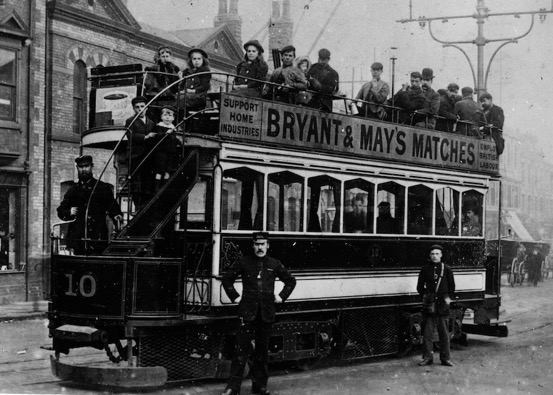
GETCo Tramcar No 10 (new in 1897) stands in Church Street, West Hartlepool, with its crew and an inspector, in 1898. Photograph courtesy of the National Tramway Museum.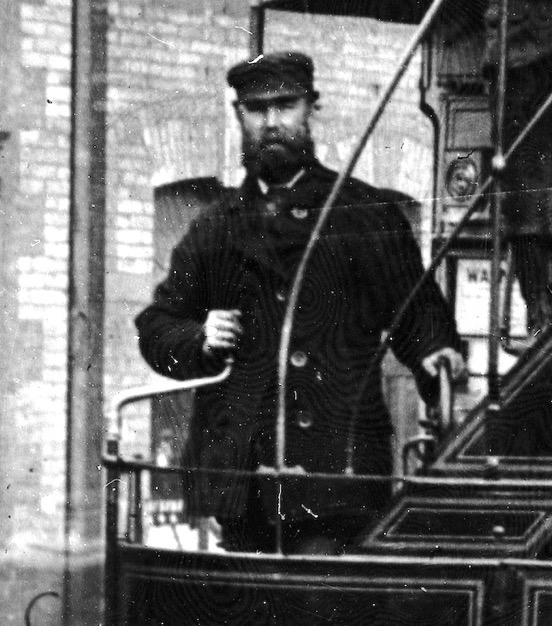
An enlargement of the above photograph showing the motorman, who though smart in appearance, appears to be wearing a jacket devoid of insignia, and a tall maritime-style of peaked cap, also without a badge of any kind.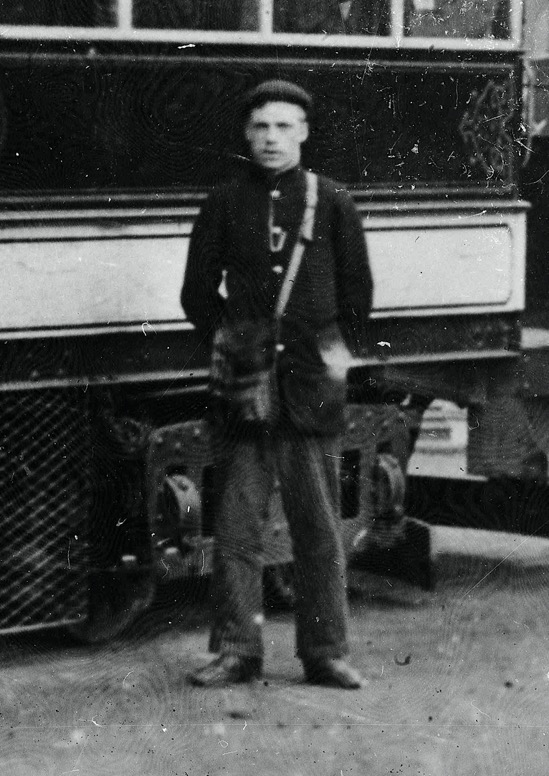
Another enlargement of the above photograph, this time showing the conductor. Whilst he is wearing an informal cap, he may to be wearing a single-breasted uniform jacket, though once again without any insignia.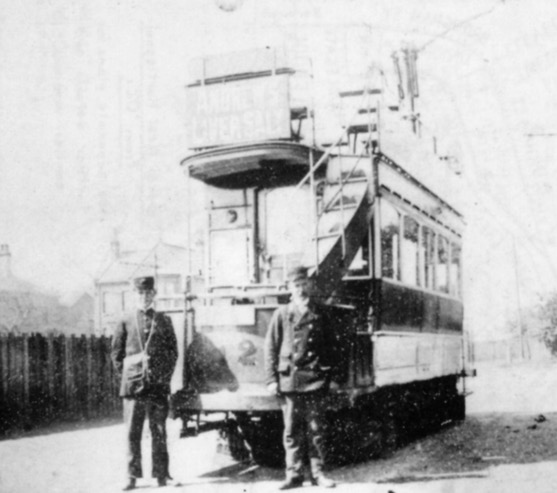
A poor quality photograph, but one which shows Tramcar No 12 (delivered new in 1899) at the temporary Sydenham Road terminus on the Foggy Furze line — photo undated, but believed to have been taken in 1902, i.e., in HETCo days. Whilst the conductor is wearing a single-breasted jacket and a kepi-style cap, the motorman has a double-breasted jacket, and possibly also a kepi-style cap. Photo courtesy of the Tramways and Light Railway Society, with thanks to David Voice.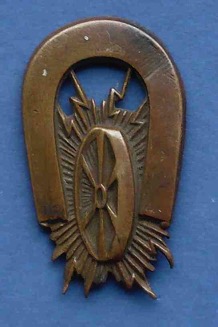
Standard British Electric Traction Company ‘Magnet & Wheel’ cap badge — brass. Although I have yet to see a photograph of a Hartlepool tramwayman showing this clearly, this is the pattern the BETCo issued to all its subsidiary operations (with the exception of the Birmingham and Black Country systems), so it would definitely have been used in Hartlepool between 1899 and the corporation take-over of 1912.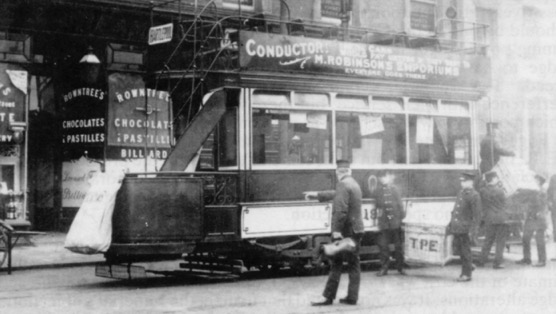
A busy scene in Victoria Road with Tramcar No 18 — undated, but thought to have been taken around 1907. The tramcar carries a large bag, presumably for parcels and packages, and the staff in the street are moving large baskets marked 'T P E', standing for 'Tramways Parcel Express'. The boys with the baskets are therefore almost certainly 'Parcels Boys' rather than tramcar crew. Photo courtesy of the Tramways and Light Railway Society, with thanks to David Voice.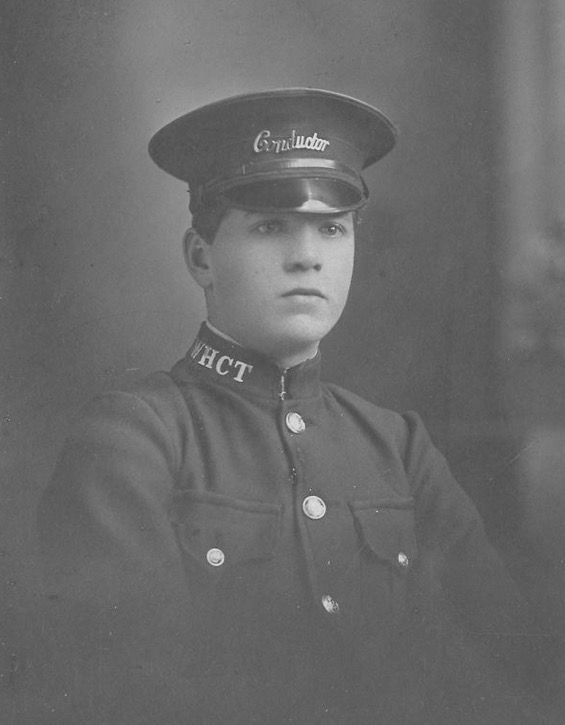
A rare studio portrait of a Hartlepool Electric Tramways' conductor — photo undated, but certainly taken in the municipal era (i.e., between late 1912 and 1927); the age of the subject suggests that it may have been taken during the Great War, when it became difficult to find men for such positions. His right-hand collar bears individual 'W H C T' initials, whilst his cap carries a standard 'off-the-shelf' grade badge; the buttons bear the standard West Hartlepool municipal device (see link). Photo courtesy of the Stephen Howarth Collection.
General pattern script-lettering cap badges — 'Motorman' and 'Conductor' — of the type used in West Hartlepool Corporation Tramways days (1912 to closure in 1927). Author's Collection.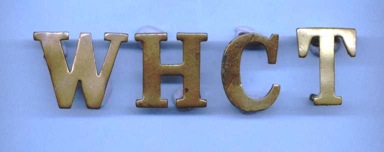
West Hartlepool Corporation Transport collar/lapel badges — brass. Author's Collection.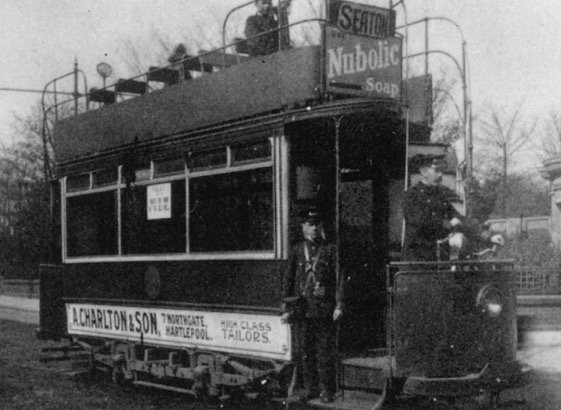
The crew of Tramcar No 18 stand at the terminus at Park in April 1914, i.e. two years after the corporation take-over. Both men are wearing script-lettering grade badges, the conductor in single-breasted jacket and the motorman in a double-breasted, lancer-style greatcoat. Photo courtesy of the Tramways and Light Railway Society, with thanks to David Voice.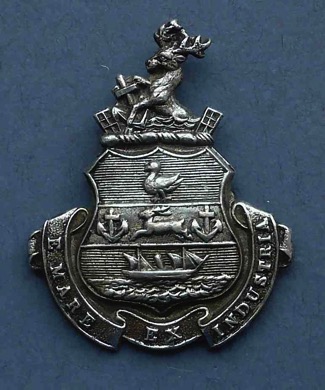
West Hartlepool Corporation Transport badge — nickel. Although this style of badge was certainly worn during the later 'Transport' era, there is currently no evidence to suggest that it was worn in tramway days. Author's Collection.
Senior staff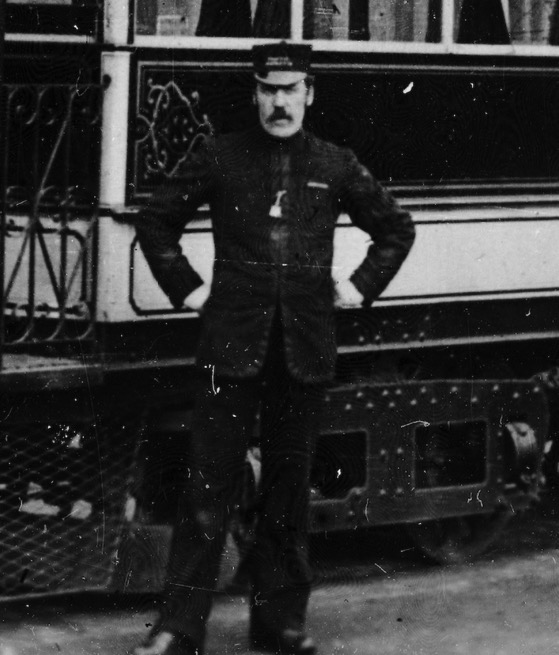
An enlargement of the 1898 photograph of Tramcar No 10 above, showing the inspector. He is wearing typical tramway inspector garb, embellished with fine edging material (and sleeve chevrons) and with a drooping-peak cap with a pom pom on top; the cap clearly carries a badge of some description, probably the grade in embroidered letters: 'TRAMWAY INSPECTOR'.